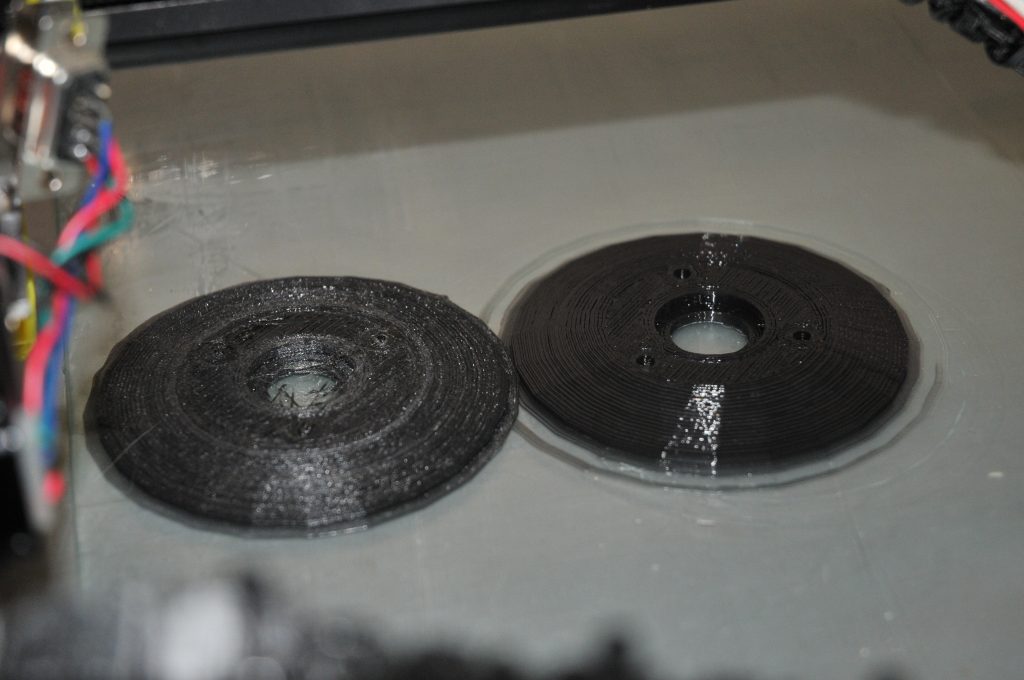One of my goals when building the printer was to be able to print nylon and other high temp materials.
For the trike, I wanted to print some parts for the chain idlers in nylon. So I ordered some Taulman Bridge nylon filament in Black. This is supposed to be one of the easier nylon variants to print. Going into this I knew that getting the nylon to stick to the build plate can be tricky and it absorbs moisture from the air which will cause printing problems.
The filament arrived, but it was repackaged, not on the original Taulman spool and keeper as shown on the Taulman website or on Amazon. It was vac bagged with no silica gel which was suspicious. I started printing at 255C with 60c bed temp on hairspray. Lots of popping noises (like Rice Krispies) and peeled up like a potato chip on the 3rd layer.
Next, I tried Elmer’s wood worker’s glue. I had some left from past woodworking projects and it was getting thick. So I thought it was worth a try after seeing the PVA recommendation on the Taulman website. This sticks incredibly well!!! Actually hard to remove if you put the glue on too thick. Still lots of popping, puffs of steam and rough textured surface. increasing the temp to 265C helped only slightly. After the first night’s attempt I had placed it in a cat litter bucket with silica gel to try to dry t out. I had a few glossy areas (must have been down by the silica gel. So I had a clue I was on the right track despite a poor overall print.
You only need a very thin coat of glue. If it is too thick, it peels off with the part. I was easily doing 6 parts per coating. Probably could do more if the location was not exactly the same each time.
The next day, I baked the spool at 220F on convect for 5 hours . This made a huge difference. Now printing nicely with a glossy finish and no popping. The spool look a bit potato chippish however. It warped due to the heat.
I am using a Hbot with Micron cobra extruder (all metal) and high flow 0.5mm nozzle. Printing @60mm/sec. I have not tried faster with the dry filament yet. Basically I am able to print at the same speed as PLA or ASA.
The parts are side plates for chain idlers for my recumbent racing trike project. They are 80mm in diameter. On the left is the “wet” version, right was made after drying the filament in the oven .
Drying the filament made a huge improvement in the print quality. Without the drying I would have rated this filament a failure.
During testing of the idler concept the strength and durability of the nylon became evident. The chain was not restrained and kept bouncing off the idler gear, deforming the nylon flanges. The same tests with PLA shattered.
Next for the printer will be new bearings for the print head carriage. A spool of iglidur180 has arrived. I will be moving from the bearing wheels to low friction fixed sliders
I also need to leave a note on the printer as to which filament was left in the head at the end of a session. I have taken to cutting the filament off at the the top of the print head and letting it cool. This avoids the jams I had been having by pulling the filament out and leaving globs of filament in the feed tube. However the range of temps I am printing with is now quite large (nylon @ 255C down to PLA at 170C). So tonight I was tring to feed in the PLA for some frame tube end caps and had to remember to crank up the temp to clean out the nylon and purge, lowering the temp as the nylon was all fed out.
